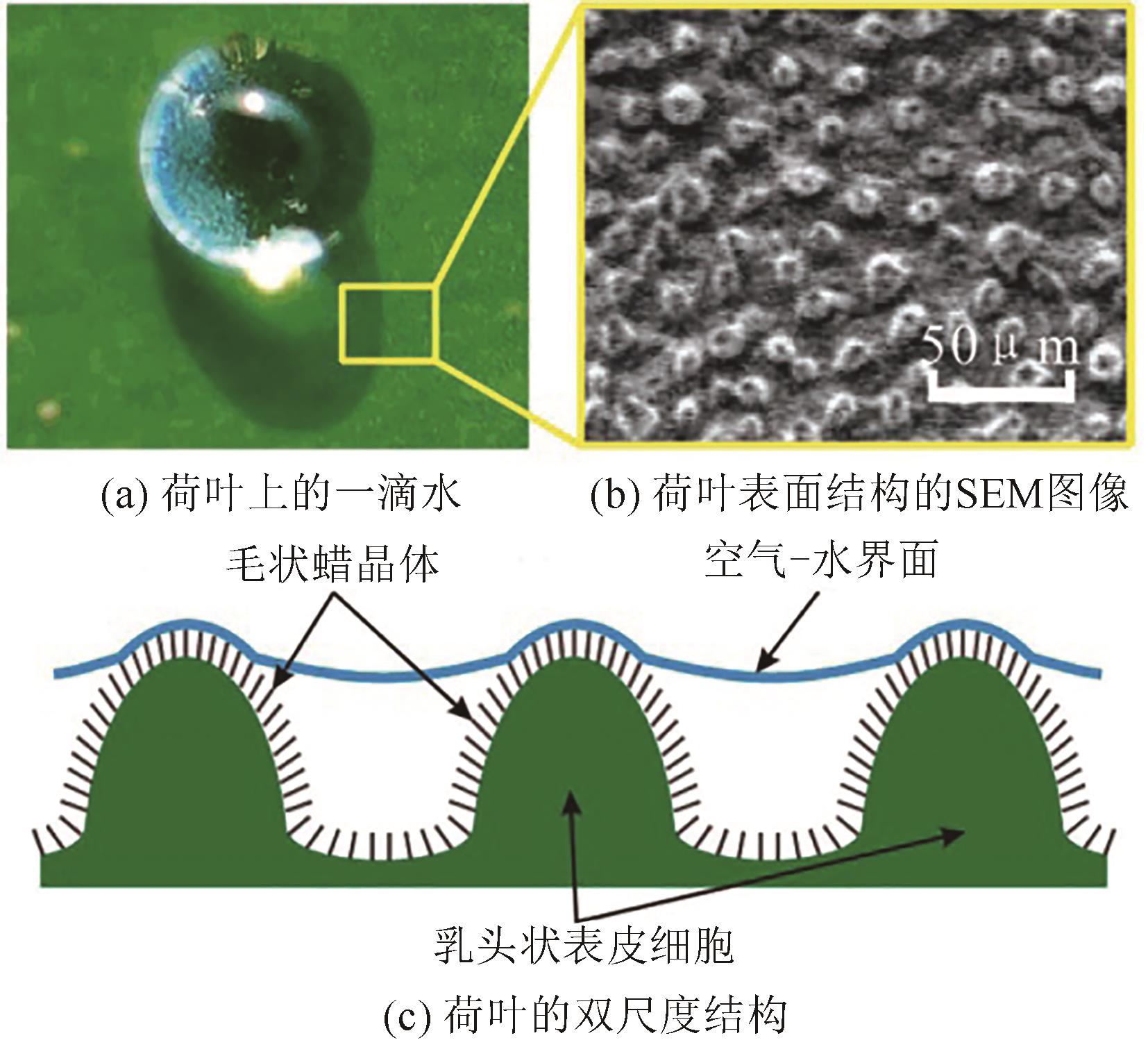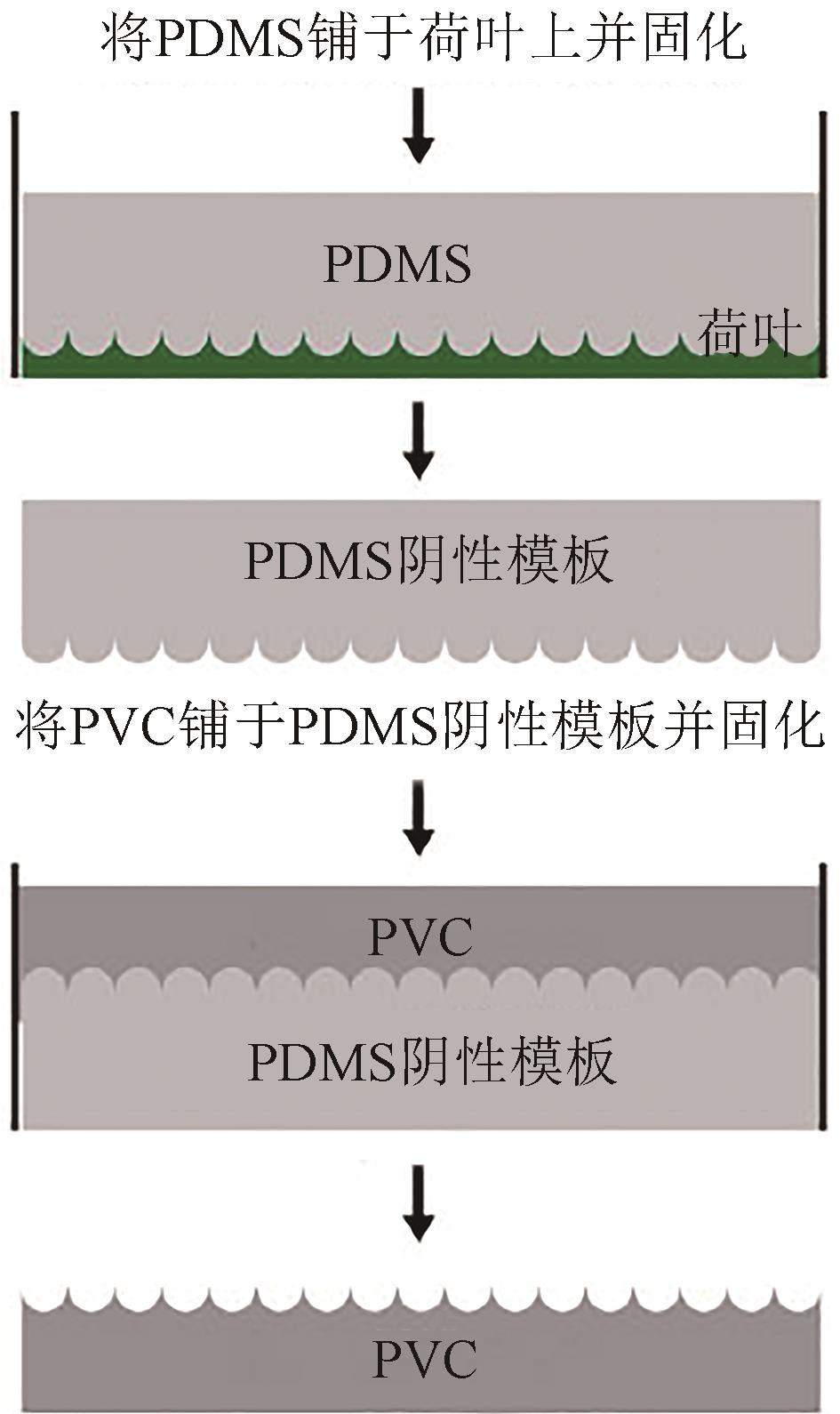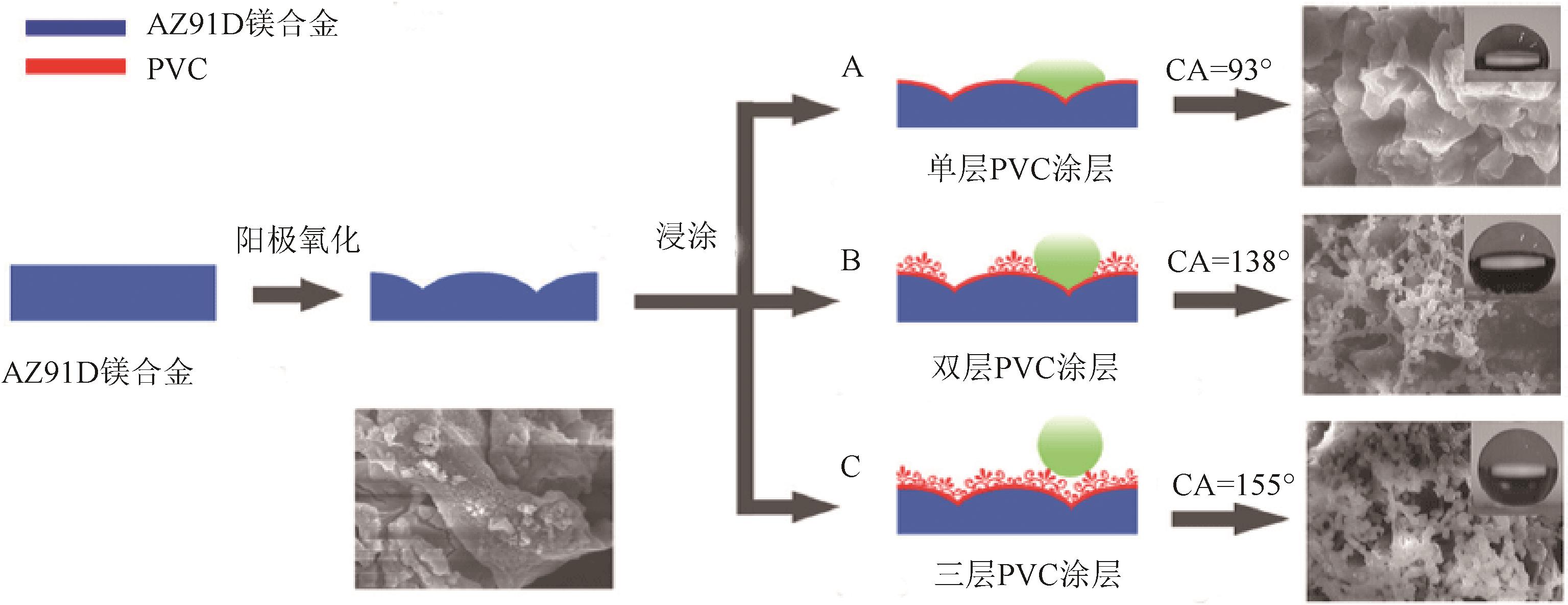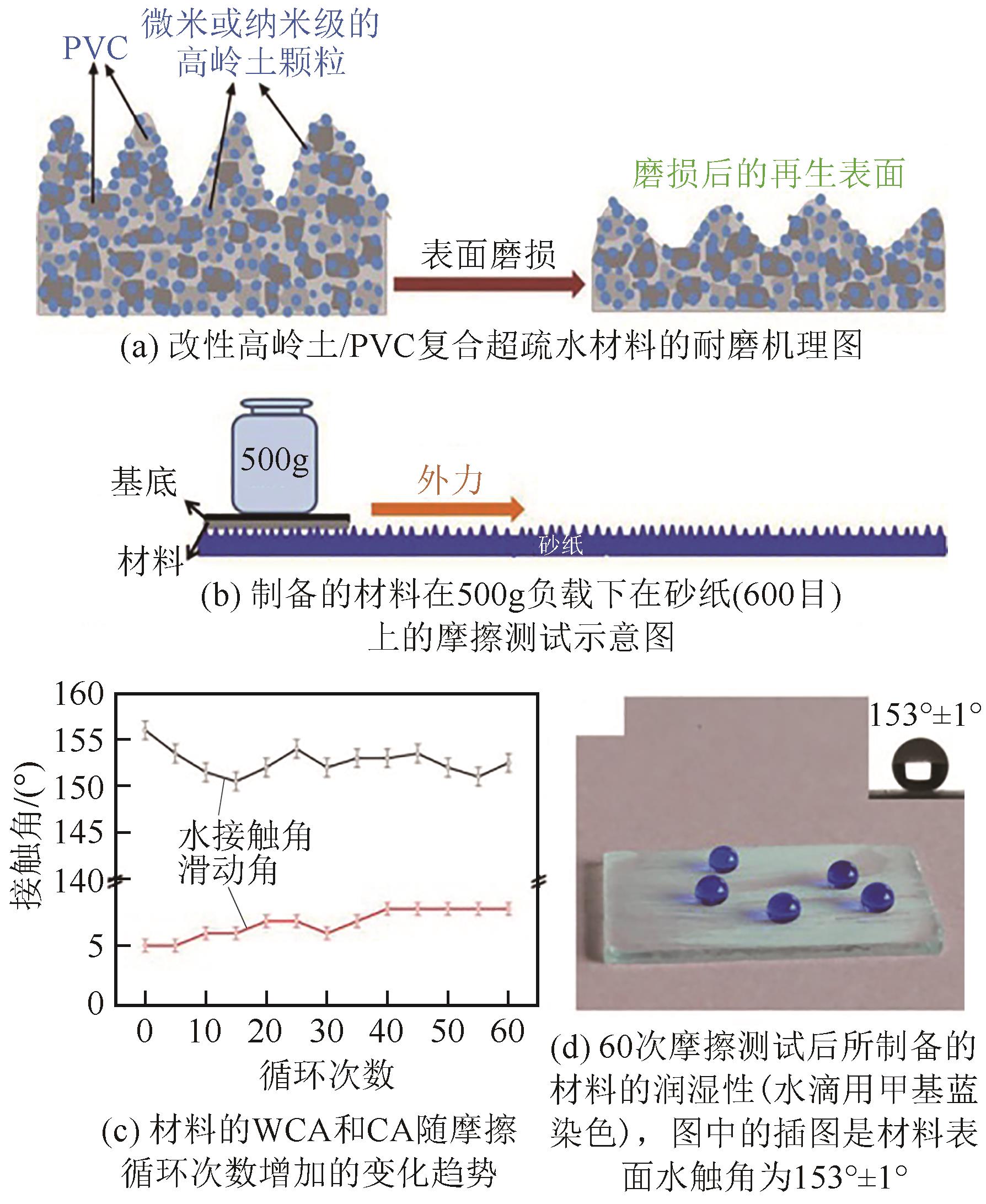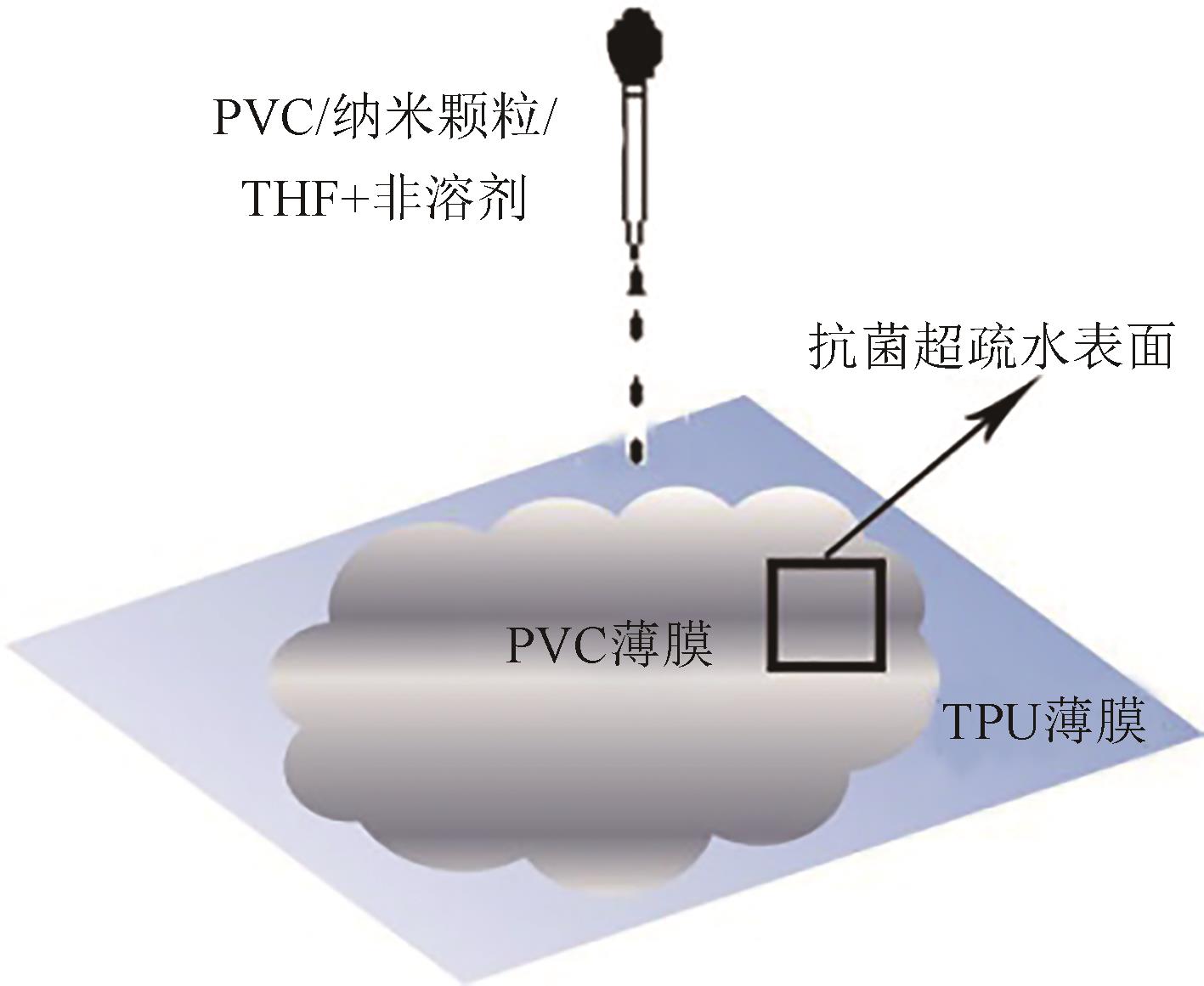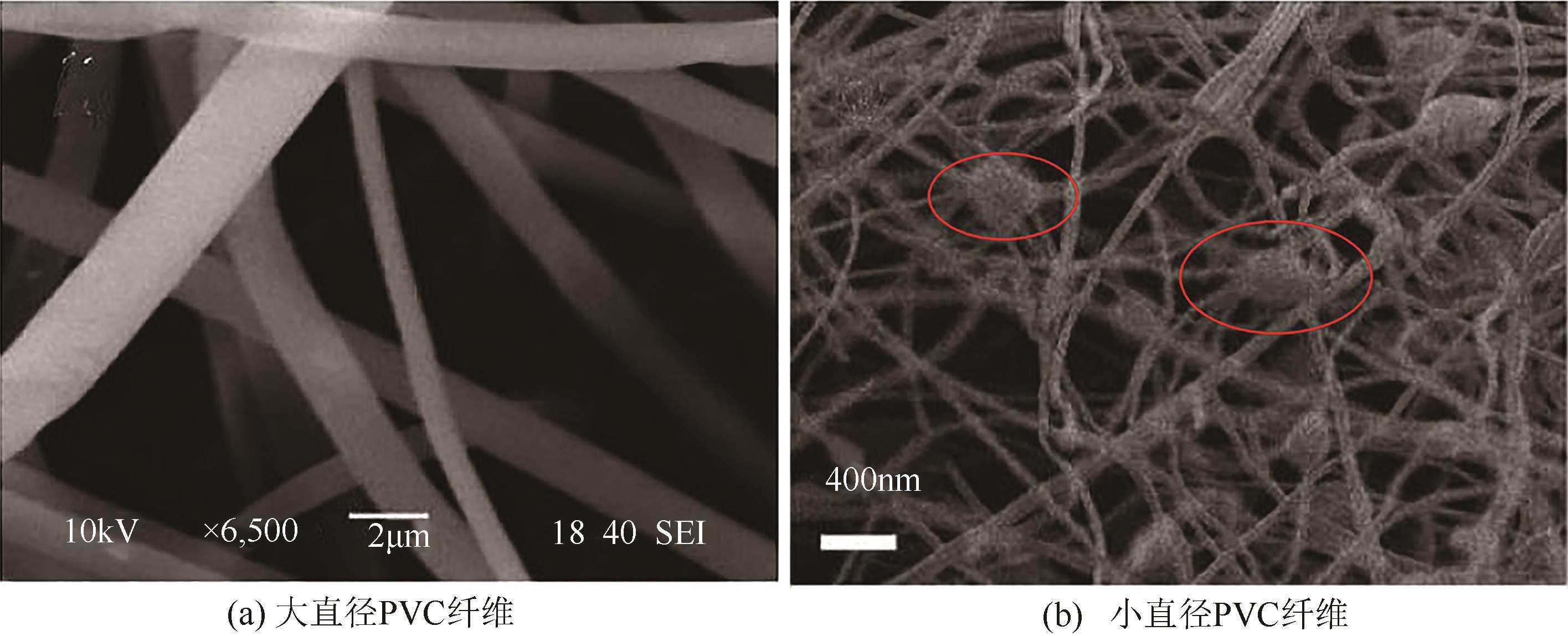化工进展 ›› 2022, Vol. 41 ›› Issue (7): 3676-3688.DOI: 10.16085/j.issn.1000-6613.2021-1683
聚氯乙烯基超疏水材料的制备及应用研究进展
朱雪丹1( ), 姚亚丽1, 马利利1, 王嘉鑫1, 杨杰2, 彭磊1, 何金梅1, 屈孟男1(
), 姚亚丽1, 马利利1, 王嘉鑫1, 杨杰2, 彭磊1, 何金梅1, 屈孟男1( )
)
- 1.西安科技大学化学与化工学院,陕西 西安 710054
2.西安科技大学安全科学与工程学院,陕西 西安 710054
-
收稿日期:2021-08-09修回日期:2021-09-18出版日期:2022-07-25发布日期:2022-07-23 -
通讯作者:屈孟男 -
作者简介:朱雪丹(1985—),女,博士研究生,研究方向为仿生功能高分子材料。E-mail:zhuxuedan@xust.edu.cn 。 -
基金资助:国家自然科学基金(51904228);陕西高校青年创新团队项目(21JP068);中国博士后科学基金(2019M663938XB);陕西省科技厅项目(2019JM-371);西安科技大学优秀青年科学基金(2019YQ2-09);西安科技大学胡杨学者计划
Progress in preparation and application of superhydrophobic materials based on polyvinyl chloride
ZHU Xuedan1( ), YAO Yali1, MA Lili1, WANG Jiaxin1, YANG Jie2, PENG Lei1, HE Jinmei1, QU Mengnan1(
), YAO Yali1, MA Lili1, WANG Jiaxin1, YANG Jie2, PENG Lei1, HE Jinmei1, QU Mengnan1( )
)
- 1.College of Chemistry and Chemical Engineering, Xi'an University of Science and Technology, Xi'an 710054, Shaanxi, China
2.College of Safty Science and Engineering, Xi'an University of Science and Technology, Xi'an 710054, Shaanxi, China
-
Received:2021-08-09Revised:2021-09-18Online:2022-07-25Published:2022-07-23 -
Contact:QU Mengnan
摘要:
聚氯乙烯(PVC)是世界上应用最广泛的塑料之一,因其具有化学和机械特性优异、廉价易得等优点而广泛应用于医疗器械制造、建筑、食品和电子等行业。PVC对水的接触角为90°,而在生物医学和金属防腐蚀等领域的应用中,需要PVC达到超疏水性能。因此,PVC基超疏水材料的需求也变得愈加迫切。本文综述了聚氯乙烯基超疏水材料的分类、制备方法和应用领域,对比了不同种类、不同制备方法的聚氯乙烯基超疏水材料的疏水性能优劣,总结出目前该领域的一些问题,主要包括制备工艺仅限于实验室操作、材料的耐磨耐久性及机械强度有待考察等,并指出该领域的发展方向:①开发简单、环保、低成本的大规模制备工艺;②克服PVC材料热、光稳定性差的弱点,发扬其耐腐蚀性好、机械强度高的优点,进一步扩大材料的应用范围。
中图分类号:
引用本文
朱雪丹, 姚亚丽, 马利利, 王嘉鑫, 杨杰, 彭磊, 何金梅, 屈孟男. 聚氯乙烯基超疏水材料的制备及应用研究进展[J]. 化工进展, 2022, 41(7): 3676-3688.
ZHU Xuedan, YAO Yali, MA Lili, WANG Jiaxin, YANG Jie, PENG Lei, HE Jinmei, QU Mengnan. Progress in preparation and application of superhydrophobic materials based on polyvinyl chloride[J]. Chemical Industry and Engineering Progress, 2022, 41(7): 3676-3688.
| 理论模型 | 二维模型 | 要点 |
|---|---|---|
| Young方程 |  | 基于理想光滑平整固体表面,接触角取决于固体表面能 |
| Wenzel模型 |  | 认为液体能完全进入固体表面的粗糙结构,粗糙度的增加有助于增加疏水固体表面的接触角 |
| Cassie-Baxter方程 |  | 认为液体与粗糙结构之间会留存空气,使得液滴不会渗透进入表面粗糙结构中,提高固-气接触面积百分比可提高接触角 |
| Cassie-Wenzel过渡态 |  | Cassie和Wenzel两种状态可以共存也可以在一定情形发生转变,Cassie模式变为Wenzel模式时,表观接触角会降低 |
表1 超疏水基本理论模型对比[4]
| 理论模型 | 二维模型 | 要点 |
|---|---|---|
| Young方程 |  | 基于理想光滑平整固体表面,接触角取决于固体表面能 |
| Wenzel模型 |  | 认为液体能完全进入固体表面的粗糙结构,粗糙度的增加有助于增加疏水固体表面的接触角 |
| Cassie-Baxter方程 |  | 认为液体与粗糙结构之间会留存空气,使得液滴不会渗透进入表面粗糙结构中,提高固-气接触面积百分比可提高接触角 |
| Cassie-Wenzel过渡态 |  | Cassie和Wenzel两种状态可以共存也可以在一定情形发生转变,Cassie模式变为Wenzel模式时,表观接触角会降低 |
| PVC膜类型 | 制备方法 | 共混聚合物/无机粒子 | 接触角 | 滑动角 | 应用领域 | 参考文献 |
|---|---|---|---|---|---|---|
| 单一PVC膜 | NIPS(乙醇) | — | 155° | 金属防腐蚀 | [ | |
| NIPS(乙醇) | — | 154° | 耐酸碱腐蚀 | [ | ||
| NIPS(乙酸) | — | 150°±1.5° | 耐酸碱腐蚀 | [ | ||
| NIPS(甲醇、乙醇) | — | 150°±3° | 抗菌 | [ | ||
| NIPS(乙醇) | — | 154° | 防生物污垢 | [ | ||
| 仿生模板法(荷叶) | — | 157°±1.8° | 3°±0.6° | [ | ||
| 含PVC的聚合物共混膜 | NIPS(水) | PVDF | 152° | 自清洁 | [ | |
| 溶剂压铸法 | 氟硅共聚物 | 117° | [ | |||
| 表面沉积 | PTFE | 150° | 除冰 | [ | ||
| PVC与无机粒子复合膜 | NIPS(乙醇) | Ag3PO4 | 156°±1° | 2°±1° | 抗菌 | [ |
| NIPS(乙醇) | 碳纳米管 | 157° | <5° | [ | ||
| NIPS(乙醇) | 疏水SiO2(自购) | 161° | <3° | 抗菌 | [ | |
| 仿生模板法(荷叶) | 疏水SiO2(HMDS) | 162° | 6° | [ | ||
| 滴涂法 | 疏水SiO2(HMDS) | 168° | 耐酸碱腐蚀 | [ | ||
| 喷涂法 | 疏水SiO2(MTMS) | 169°±2° | 6° | 自清洁、透明 | [ | |
| 旋涂法 | 疏水SiO2(TMCS) | 162° | 金属防腐蚀 | [ | ||
| 滴涂法 | 石英砂(DEDMS) | 156° | 6° | 耐磨耐久 | [ | |
| 滴涂法 | 高岭土(硬脂酸) | 156° | <10° | 耐磨耐腐蚀 | [ | |
| 浸涂法 | CS和ZnO | 154° | 金属防腐蚀 | [ | ||
| 静电纺丝 | ZnO | 146.39° | 金属防腐蚀 | [ | ||
| 静电纺丝 | TiO2/石墨烯 | 168.3°/161° | 光电极 | [ |
表2 不同种类、制备方法的聚氯乙烯基超疏水材料的性能对比
| PVC膜类型 | 制备方法 | 共混聚合物/无机粒子 | 接触角 | 滑动角 | 应用领域 | 参考文献 |
|---|---|---|---|---|---|---|
| 单一PVC膜 | NIPS(乙醇) | — | 155° | 金属防腐蚀 | [ | |
| NIPS(乙醇) | — | 154° | 耐酸碱腐蚀 | [ | ||
| NIPS(乙酸) | — | 150°±1.5° | 耐酸碱腐蚀 | [ | ||
| NIPS(甲醇、乙醇) | — | 150°±3° | 抗菌 | [ | ||
| NIPS(乙醇) | — | 154° | 防生物污垢 | [ | ||
| 仿生模板法(荷叶) | — | 157°±1.8° | 3°±0.6° | [ | ||
| 含PVC的聚合物共混膜 | NIPS(水) | PVDF | 152° | 自清洁 | [ | |
| 溶剂压铸法 | 氟硅共聚物 | 117° | [ | |||
| 表面沉积 | PTFE | 150° | 除冰 | [ | ||
| PVC与无机粒子复合膜 | NIPS(乙醇) | Ag3PO4 | 156°±1° | 2°±1° | 抗菌 | [ |
| NIPS(乙醇) | 碳纳米管 | 157° | <5° | [ | ||
| NIPS(乙醇) | 疏水SiO2(自购) | 161° | <3° | 抗菌 | [ | |
| 仿生模板法(荷叶) | 疏水SiO2(HMDS) | 162° | 6° | [ | ||
| 滴涂法 | 疏水SiO2(HMDS) | 168° | 耐酸碱腐蚀 | [ | ||
| 喷涂法 | 疏水SiO2(MTMS) | 169°±2° | 6° | 自清洁、透明 | [ | |
| 旋涂法 | 疏水SiO2(TMCS) | 162° | 金属防腐蚀 | [ | ||
| 滴涂法 | 石英砂(DEDMS) | 156° | 6° | 耐磨耐久 | [ | |
| 滴涂法 | 高岭土(硬脂酸) | 156° | <10° | 耐磨耐腐蚀 | [ | |
| 浸涂法 | CS和ZnO | 154° | 金属防腐蚀 | [ | ||
| 静电纺丝 | ZnO | 146.39° | 金属防腐蚀 | [ | ||
| 静电纺丝 | TiO2/石墨烯 | 168.3°/161° | 光电极 | [ |
| 1 | LAW K Y. Definitions for hydrophilicity, hydrophobicity, and superhydrophobicity: getting the basics right[J].The Journal of Physical Chemistry Letters, 2014, 5 (4): 686-688. |
| 2 | WENZEL R N. Resistance of solid surfaces to wetting by water[J]. Industrial & Engineering Chemistry, 2002, 28(8): 988-994. |
| 3 | CASSIE A B D, BAXTER S. Wettability of porous surfaces[J]. Transactions of the Faraday Society, 1944, 40: 546-551. |
| 4 | FENG X J, JIANG L. Design and creation of superwetting/antiwetting surfaces[J]. Advanced Materials, 2006, 18(23): 3063-3078. |
| 5 | NEINHUIS C, BARTHLOTT W. Characterization and distribution of water-repellent, self-cleaning plant surfaces[J]. Annals of Botany, 1997,79(6): 667-677. |
| 6 | BARTHLOTT W, NEINHUIS C. Purity of the sacred lotus, or escape from contamination in biological surfaces[J]. Planta, 1997, 202(1):1-8. |
| 7 | FENG L, LI S, LI Y, et al. Super-hydrophobic surfaces: from natural to artificial[J]. Advanced Materials, 2002, 14(24):1857-1860. |
| 8 | YU Y, ZHAO Z H, ZHENG Q S. Mechanical and superhydrophobic stabilities of two-scale surfacial structure of lotus leaves[J]. Langmuir, 2007, 23(15): 8212-8216. |
| 9 | LUO C, ZUO X, WANG L, et al. Flexible carbon nanotube-polymer composite films with high conductivity and superhydrophobicity made by solution process[J]. Nano Letters, 2008, 8(12):4454-4458. |
| 10 | HU Z H, SUN M, LYU M, et al. Deciphering buried air phases on natural and bioinspired superhydrophobic surfaces using synchrotron radiation-based X-ray phase-contrast imaging[J]. NPG Asia Materials, 2016, 8(9):e306. |
| 11 | MCKEEN L W. Handbook of polymer applications in medicine and medical devices: 3. Plastics used in medical devices[M]. Elsevier Inc. Chapters, 2013. |
| 12 | YUAN Z Q, CHEN H, ZHANG J D. Facile method to prepare lotus-leaf-like super-hydrophobic poly(vinyl chloride) film[J]. Applied Surface Science, 2008, 254(6):1593-1598. |
| 13 | CHEN H, YUAN Z Q, ZHANG J D, et al. Preparation, characterization and wettability of porous superhydrophobic poly(vinyl chloride) surface[J]. Journal of Porous Materials, 2009, 16(4): 447-451. |
| 14 | YANG N, LI J C, BAI N N, et al. One step phase separation process to fabricate superhydrophobic PVC films and its corrosion prevention for AZ91D magnesium alloy[J]. Materials Science and Engineering B, 2016, 209: 1-9. |
| 15 | KOPONEN H K, SAARIKOSKI I, KORHONEN T, et al. Modification of cycloolefin copolymer and poly(vinyl chloride)surfaces by superimposition of nano- and microstructures[J]. Applied Surface Science, 2007, 253(12):5208-5213. |
| 16 | GURAV A B, LATTHE S S, VHATKAR R S, et al. Superhydrophobic surface decorated with vertical ZnO nanorods modified by stearic acid[J]. Ceramics International, 2014, 40(5):7151-7160. |
| 17 | KOKARE A M, SUTAR R S, DESHMUKH S G, et al. ODS-modified TiO2 nanoparticles for the preparation of self-cleaning superhydrophobic coating[J]. AIP Conference Proceedings, 2018, 1953(1): 100068. |
| 18 | LATTHE S S, NAKATA K, HÖFER R, et al. CHAPTER 5. Lotus effect-based superhydrophobic surfaces: candle soot as a promising class of nanoparticles for self-cleaning and oil-water separation applications[M]//Green Chemistry Series. Cambridge: Royal Society of Chemistry, 2019: 92-119. |
| 19 | SUTAR R S, KALEL P J, LATTHE S S, et al. Superhydrophobic PVC/SiO2 coating for self-cleaning application[J]. Macromolecular Symposia, 2020, 393(1): 2000034. |
| 20 | YILGOR I, BILGIN S, ISIK M, et al. Facile preparation of superhydrophobic polymer surfaces[J]. Polymer, 2012, 53(6):1180-1188. |
| 21 | YOON H, KIM H, LATTHE S S, et al. A highly transparent self-cleaning superhydrophobic surface by organosilane-coated alumina particles deposited via electrospraying[J]. Journal of Materials Chemistry A, 2015, 3(21):11403-11410. |
| 22 | GUO Y G, WANG Q H. Facile approach in fabricating superhydrophobic coatings from silica-based nanocomposite[J]. Applied Surface Science, 2010, 257(1): 33-36. |
| 23 | PAWAR P G, XING R M, KAMBALE R C, et al. Polystyrene assisted superhydrophobic silica coatings with surface protection and self-cleaning approach[J]. Progress in Organic Coatings, 2017, 105:235-244. |
| 24 | ZHANG X, DING B, CHENG R, et al. Computational intelligence-assisted understanding of nature-inspired superhydrophobic behavior[J]. Advanced Science, 2018, 5(1): 1700520. |
| 25 | CHEN H Z, ZHANG X, ZHANG P Y, et al. Facile approach in fabricating superhydrophobic SiO2/polymer nanocomposite coating[J]. Applied Surface Science, 2012, 261: 628-632. |
| 26 | LATTHE S S, SUTAR R S, KODAG V S, et al. Self-cleaning superhydrophobic coatings: potential industrial applications[J]. Progress in Organic Coatings, 2019, 128: 52-58. |
| 27 | QU M N, LIU S S, HE J M, et al. Fabrication of recyclable superhydrophobic materials with self-cleaning and mechanically durable properties on various substrates by quartz sand and polyvinylchloride[J]. RSC Advances, 2016, 6(82): 79238-79244. |
| 28 | QU M N, LIU S S, HE J M, et al. Fabrication of recyclable and durable superhydrophobic materials with wear/corrosion-resistance properties from kaolin and polyvinylchloride[J]. Applied Surface Science, 2017, 410: 299-307. |
| 29 | SEYFI J, PANAHI-SARMAD M, ORAEIGHODOUSI A, et al. Antibacterial superhydrophobic polyvinyl chloride surfaces via the improved phase separation process using silver phosphate nanoparticles[J]. Colloids and Surfaces B Biointerfaces, 2019, 183: 110438. |
| 30 | IRIBARREN A, RIVERO P, BERLANGA C, et al. Multifunctional protective PVC-ZnO nanocomposite coatings deposited on aluminum alloys by electrospinning[J]. Coatings, 2019, 9(4): 216. |
| 31 | RIVERO P J, IRIBARREN A, LARUMBE S, et al. A comparative study of multifunctional coatings based on electrospun fibers with incorporated ZnO nanoparticles[J]. Coatings, 2019, 9(6): 367. |
| 32 | MOLLA-ABBASI P. Effect of nano-size nodular structure induced by CNT-promoted phase separation on the fabrication of superhydrophobic polyvinyl chloride films[J]. Polymers for Advanced Technologies, 2021, 32(1):391-401. |
| 33 | RIOBOO R, DEMNATI I, ALI M A, et al. Superhydrophobicity of composite surfaces created from polymer blends[J]. Journal of Colloid and Interface Science, 2020, 560: 596-605. |
| 34 | 张大帅.超疏水PVDF/PVC复合膜的制备及其在膜蒸馏海水淡化中的应用[D].海口: 海南师范大学, 2020. |
| ZHANG Dashuai. Preparation of superhydrophobic PVDF/PVC composite membrane and application in membrane distillation for desalination [D]. Haikou: Hainan Normal University, 2020. | |
| 35 | ERBIL H Y, DEMIREL A L, AVCı Y, et al. Transformation of a simple plastic into a superhydrophobic surface[J]. Science, 2003, 299(5611): 1377-1380. |
| 36 | 周存, 秦兆立, 王闻宇, 等. 动力/储能锂离子电池隔膜制备先进技术及研究进展[J].材料导报, 2018, 32(23): 4051-4060. |
| ZHOU Cun, QIN Zhaoli, WANG Wenyu, et al. The state-of-the-art preparation technology of separator for power/energy storage lithium ion battery: a review[J]. Materials Review, 2018, 32(23): 4051-4060. | |
| 37 | 侯瑞, 李桂群, 张岩, 等.聚合物相分离技术在超疏水表面制备中的应用[J].化工进展, 2020, 39(2): 616-626. |
| HOU Rui, LI Guiqun, ZHANG Yan, et al. Application of polymer phase separation technique in preparation of superhydrophobic surface[J]. Chemical Industry and Engineering Progress, 2020, 39(2): 616-626. | |
| 38 | PATEL S U, CHASE G G. Separation of water droplets from water-in-diesel dispersion using superhydrophobic polypropylene fibrous membranes[J]. Separation and Purification Technology, 2014, 126: 62-68. |
| 39 | YUAN Z Q, CHEN H, TANG J X, et al. Facile method to fabricate stable superhydrophobic polystyrene surface by adding ethanol[J]. Surface and Coatings Technology, 2007, 201(16/17): 7138-7142. |
| 40 | KANG Y K, WANG J Y, YANG G B, et al. Preparation of porous super-hydrophobic and super-oleophilic polyvinyl chloride surface with corrosion resistance property[J]. Applied Surface Science, 2011, 258(3): 1008-1013. |
| 41 | MAGHSOUDI K, VAZIRINASAB E, MOMEN G, et al. Advances in the fabrication of superhydrophobic polymeric surfaces by polymer molding processes[J]. Industrial & Engineering Chemistry Research, 2020, 59(20): 9343-9363. |
| 42 | 邓建辉, 杨晓青, 方称辉, 等. 静电纺丝/静电喷雾技术在电池领域的应用进展[J].化工进展,2021, 40(10): 5600-5614. |
| DENG Jianhui, YANG Xiaoqing, FANG Chenhui, et al. Application of electrospinning and electrospray technology in battery/cell field[J]. Chemical Industry and Engineering Progress, 2021, 40(10): 5600-5614. | |
| 43 | BAO Q L, ZHANG H, YANG J X, et al. Graphene-polymer nanofiber membrane for ultrafast photonics[J]. Advanced Functional Materials, 2010, 20(5): 782-791. |
| 44 | ZHAO R, LU X F, WANG C. Electrospinning based all-nano composite materials: recent achievements and perspectives[J]. Composites Communications, 2018, 10: 140-150. |
| 45 | RENEKER D H, YARIN A L, FONG H, et al. Bending instability of electrically charged liquid jets of polymer solutions in electrospinning[J]. Journal of Applied Physics, 2000, 87(9): 4531-4547. |
| 46 | SHIN Y M, HOHMAN M M, BRENNER M P, et al. Electrospinning: a whipping fluid jet generates submicron polymer fibers[J]. Applied Physics Letters, 2001, 78(8): 1149-1151. |
| 47 | LEE J K Y, CHEN N, PENG S J, et al. Polymer-based composites by electrospinning: preparation & functionalization with nanocarbons[J]. Progress in Polymer Science, 2018, 86: 40-84. |
| 48 | 岳青, 王绍德, 徐飞, 等. 静电纺丝技术及其在各领域中的应用[J].材料导报, 2021, 35(S1): 594-599. |
| YUE Qing, WANG Shaode, XU Fei, et al. Electrostatic spinning technology and its application in various fields[J]. Materials Reports, 2021, 35(S1): 594-599. | |
| 49 | MA M, GUPTA M, LI Z, et al. Decorated electrospun fibers exhibiting superhydrophobicity[J]. Advanced Materials, 2007, 19(2): 255-259. |
| 50 | ACATAY K, SIMSEK E, OW-YANG C, et al. Tunable, superhydrophobically stable polymeric surfaces by electrospinning[J]. Angewandte Chemie International Edition, 2004, 43(39): 5210-5213. |
| 51 | PARK S H, LEE S M, LIM H S, et al. Robust superhydrophobic mats based on electrospun crystalline nanofibers combined with a silane precursor[J]. ACS Applied Materials & Interfaces, 2010, 2(3): 658-662. |
| 52 | RIVERO P, GARCIA J, QUINTANA I, et al. Design of nanostructured functional coatings by using wet-chemistry methods[J]. Coatings, 2018,8(2): 76. |
| 53 | ASMATULU R, CEYLAN M, NURAJE N. Study of superhydrophobic electrospun nanocomposite fibers for energy systems[J]. Langmuir, 2011, 27(2): 504-507. |
| 54 | LEE K H, KIM H Y, LA Y M, et al. Influence of a mixing solvent with tetrahydrofuran and N,N-dimethylformamide on electrospun poly(vinyl chloride) nonwoven mats[J]. Journal of Polymer Science B: Polymer Physics, 2002, 40(19): 2259-2268. |
| 55 | KIM D K, LEE S B, DOH K S. Surface properties of fluorosilicone copolymers and their surface modification effects on PVC film[J]. Journal of Colloid and Interface Science, 1998, 205(2): 417-422. |
| 56 | JIANG Z Q, WANG X Q, JIA H Y, et al. Superhydrophobic polytetrafluoroethylene/heat-shrinkable polyvinyl chloride composite film with super anti-icing property[J]. Polymers, 2019, 11(5): 805. |
| 57 | LI C Q, ZHU M Y, OU J F, et al. Dynamic corrosion behavior of superhydrophobic surfaces[J]. RSC Advances, 2018, 8(51): 29201-29209. |
| 58 | MOHAMED A M A, ABDULLAH A M, YOUNAN N A. Corrosion behavior of superhydrophobic surfaces: a review[J]. Arabian Journal of Chemistry, 2015, 8(6): 749-765. |
| 59 | JEEN ROBERT R B, HIKKU G S, JEYASUBRAMANIAN K, et al. ZnO nanoparticles impregnated polymer composite as superhydrophobic anti-corrosive coating for aluminium-6061 alloy[J]. Materials Research Express, 2019, 6(7): 75705. |
| 60 | GABRIEL M, STRAND D, VAHL C F. Cell adhesive and antifouling polyvinyl chloride surfaces via wet chemical modification[J]. Artificial Organs, 2012, 36(9): 839-844. |
| 61 | LAKSHMI S, JAYAKRISHNAN A. Migration resistant, blood-compatible plasticized polyvinyl chloride for medical and related applications[J]. Artificial Organs, 1998, 22(3): 222-229. |
| 62 | MILIANI K, MIGUERES B, VERJAT-TRANNOY D, et al. National point prevalence survey of healthcare-associated infections and antimicrobial use in French home care settings, May to June 2012[J]. Euro Surveillance, 2015, 20(27): 12-22. |
| 63 | NAEEMABADI N, SEYFI J, HEJAZI E, et al. Investigation on surface properties of superhydrophobic nanocomposites based on polyvinyl chloride and correlation with cell adhesion behavior[J]. Polymers for Advanced Technologies, 2019, 30(4): 1027-1035. |
| 64 | LOO C Y, YOUNG P M, LEE W H, et al. Superhydrophobic, nanotextured polyvinyl chloride films for delaying Pseudomonas aeruginosa attachment to intubation tubes and medical plastics[J]. Acta Biomaterialia, 2012, 8(5): 1881-1890. |
| 65 | HELLIO C, YEBRA D. Advances in marine antifouling coatings and technologies[M]. Oxford: Woodhead Publishing Series, Limited, 2009. |
| 66 | IYAPPARAJ P, REVATHI P, RAMASUBBURAYAN R, et al. Antifouling and toxic properties of the bioactive metabolites from the seagrasses Syringodium isoetifolium and Cymodocea serrulata [J]. Ecotoxicology and Environmental Safety, 2014, 103: 54-60. |
| 67 | GUDIPATI C S, FINLAY J A, CALLOW J A, et al. The antifouling and fouling-release perfomance of hyperbranched fluoropolymer (HBFP)-poly(ethylene glycol) (PEG) composite coatings evaluated by adsorption of biomacromolecules and the green fouling alga ulva[J]. Langmuir, 2005, 21(7): 3044-3053. |
| 68 | MARMUR A. Super-hydrophobicity fundamentals: implications to biofouling prevention[J]. Biofouling, 2006, 22(1/2): 107-115. |
| 69 | 王强, 李昌诚, 闫雪峰 等. 低表面能海洋防污涂层技术及其评价方法[J].材料导报, 2008, 22(10): 84-87, 94. |
| WANG Qiang, LI Changcheng, YAN Xuefeng, et al. Marine antifouling coating technology with low surface energy and its evaluation methods[J]. Materials Review, 2008, 22(10): 84-87, 94. | |
| 70 | BROWN R, RUSSELL S, MAY S, et al. Reproducible superhydrophobic PVC coatings; investigating the use of plasticizers for early stage biofouling control[J]. Advanced Engineering Materials, 2017, 19(7): 1700053. |
| 71 | WANG Y B, XU Y M, HUANG Q. Progress on ultrasonic guided waves de-icing techniques in improving aviation energy efficiency[J]. Renewable and Sustainable Energy Reviews, 2017, 79: 638-645. |
| 72 | ZUO Z P, LIAO R J, GUO C, et al. Fabrication and anti-icing property of coral-like superhydrophobic aluminum surface[J]. Applied Surface Science, 2015, 331: 132-139. |
| 73 | 余春浩, 宫敬, 郝鹏飞, 等. 超疏水表面防结冰结霜性能的研究进展[J].材料导报, 2014, 28(13): 65-68. |
| YU Chunhao, GONG Jing, HAO Pengfei, et al. Progress of anti-icing and anti-frosting properties of super hydrophobic surface[J]. Mterials Review, 2014, 28(13): 65-68. | |
| 74 | LONG Y F, YIN X X, MU P, et al. Slippery liquid-infused porous surface (SLIPS) with superior liquid repellency, anti-corrosion, anti-icing and intensified durability for protecting substrates[J]. Chemical Engineering Journal, 2020, 401: 126137. |
| [1] | 高彦静. 单原子催化技术国际研究态势分析[J]. 化工进展, 2023, 42(9): 4667-4676. |
| [2] | 谈继淮, 余敏, 张彤彤, 黄能坤, 王梓雯, 朱新宝. 新型栲胶聚丙氧基醚酯的合成及增塑PVC性能[J]. 化工进展, 2023, 42(9): 4847-4855. |
| [3] | 李志远, 黄亚继, 赵佳琪, 于梦竹, 朱志成, 程好强, 时浩, 王圣. 污泥与聚氯乙烯共热解重金属特性[J]. 化工进展, 2023, 42(9): 4947-4956. |
| [4] | 吴海波, 王希仑, 方岩雄, 纪红兵. 3D打印催化材料开发与应用进展[J]. 化工进展, 2023, 42(8): 3956-3964. |
| [5] | 毛善俊, 王哲, 王勇. 基团辨识加氢:从概念到应用[J]. 化工进展, 2023, 42(8): 3917-3922. |
| [6] | 李润蕾, 王子彦, 王志苗, 李芳, 薛伟, 赵新强, 王延吉. CuO-CeO2/TiO 2 高效催化CO低温氧化反应性能[J]. 化工进展, 2023, 42(8): 4264-4274. |
| [7] | 王鑫, 王兵兵, 杨威, 徐志明. 金属表面PDA/PTFE超疏水涂层抑垢与耐腐蚀性能[J]. 化工进展, 2023, 42(8): 4315-4321. |
| [8] | 储甜甜, 刘润竹, 杜高华, 马嘉浩, 张孝阿, 王成忠, 张军营. 有机胍催化脱氢型RTV硅橡胶的制备和可降解性能[J]. 化工进展, 2023, 42(7): 3664-3673. |
| [9] | 俞俊楠, 俞建峰, 程洋, 齐一搏, 化春键, 蒋毅. 基于深度学习的变宽度浓度梯度芯片性能预测[J]. 化工进展, 2023, 42(7): 3383-3393. |
| [10] | 孙旭东, 赵玉莹, 李诗睿, 王琦, 李晓健, 张博. 我国地方性氢能发展政策的文本量化分析[J]. 化工进展, 2023, 42(7): 3478-3488. |
| [11] | 陈香李, 李倩倩, 张甜, 李彪, 李康康. 自愈合油水分离膜的研究进展[J]. 化工进展, 2023, 42(7): 3600-3610. |
| [12] | 刘战剑, 付雨欣, 任丽娜, 张曦光, 袁中涛, 杨楠, 汪怀远. 超疏水涂层在防腐阻垢领域研究进展[J]. 化工进展, 2023, 42(6): 2999-3011. |
| [13] | 徐国彬, 刘洪豪, 李洁, 郭家奇, 王琪. ZnO量子点水性喷墨荧光墨水制备及性能[J]. 化工进展, 2023, 42(6): 3114-3122. |
| [14] | 杨家添, 唐金铭, 梁恣荣, 黎胤宏, 胡华宇, 陈渊. 新型淀粉基高吸水树脂抑尘剂的制备及其应用[J]. 化工进展, 2023, 42(6): 3187-3196. |
| [15] | 金涌, 程易, 白丁荣, 张晨曦, 魏飞. 中国流态化技术研发史略[J]. 化工进展, 2023, 42(6): 2761-2780. |
| 阅读次数 | ||||||
|
全文 |
|
|||||
|
摘要 |
|
|||||
